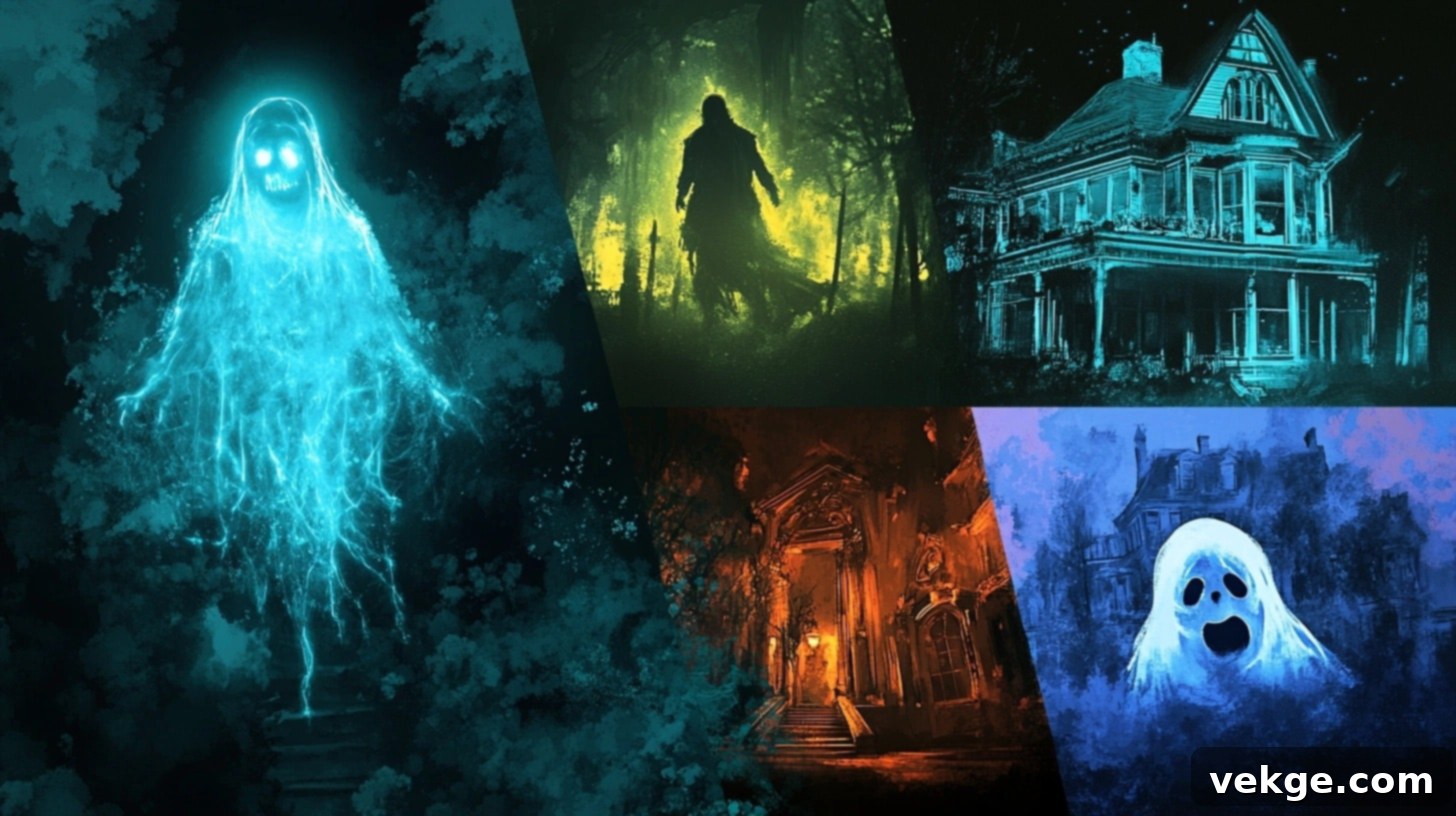Unveiling the Unseen: 15 Ethereal Ghost Painting Techniques for Captivating Art
Stepping into the studio, witnessing the moon’s gentle light transform ordinary shadows into captivating, dancing spirits, serves as a powerful reminder of why ghost painting continues to enchant countless artists. It’s more than just a creative pursuit; it’s an exploration of the liminal, the space where reality softly blurs into imagination.
My journey into spectral art began two decades ago, where I quickly learned that painting ghosts extends far beyond merely depicting white forms on dark canvases. It’s about skillfully capturing the elusive essence, the profound space that exists between what is seen and what remains unseen, inviting viewers to ponder the mysteries beyond our grasp.
Each ghost painting we create holds a unique narrative, a whispered story suspended between the tangible world and the limitless realm of fantasy. Through thoughtfully chosen techniques and meticulous composition, artists can draw observers into that enchanting threshold where the everyday converges with the extraordinary, evoking a sense of wonder and intrigue.
Whether you are a seasoned artist with years of experience under your belt or someone who is just picking up a brush for the very first time, this comprehensive guide offers 15 distinct ghost painting techniques. These methods will empower you to breathe life into your supernatural visions and create truly captivating, ethereal masterpieces that resonate with a unique spectral charm.
Join us as we embark on this artistic adventure, discovering how simple pigments and thoughtful strokes can magically give tangible form to the formless, transforming abstract ideas into breathtaking works of spectral art.
List of Ghost Painting Ideas to Try
1. Luminous Spirit Creation
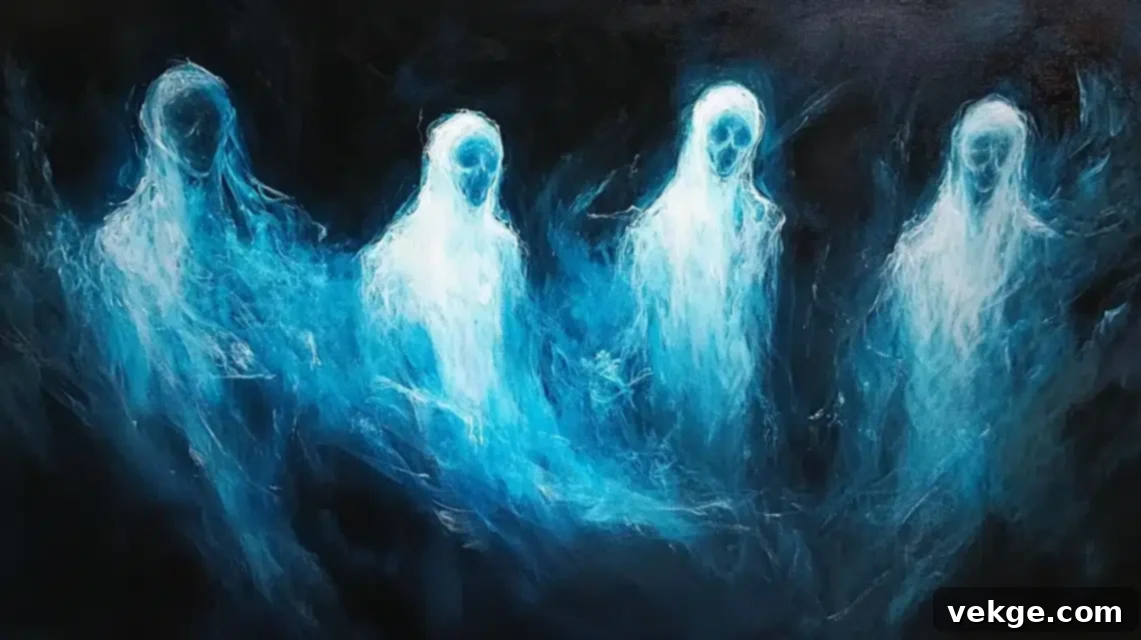
Unlike conventional ghost paintings, these glow-in-the-dark spirits truly awaken and reveal their magic when the ambient lights are dimmed. Experiments in the studio have shown how various phosphorescent paints can produce a spectrum of enchanting effects as evening progresses. The true artistry lies in the meticulous layering process; multiple translucent coats gradually build an extraordinary depth that only fully manifests once darkness falls. By day, these creations appear as subtle white figures, but by night, they dramatically transform into vibrant, glowing apparitions.
Consider the profound impact different colored base layers can have on the final luminous glow. For instance, incorporating blue undertones can help cultivate cool, intensely ethereal spirits, while warm, inviting bases tend to suggest friendlier, more comforting phantoms, allowing for a wide range of emotional expression.
Complete Painting Process:
- Prepare the Canvas: Begin with a dark canvas, applying a deep blue or black base to create the ideal, mysterious backdrop for your ghostly appearances.
- Sketch Details: Lightly sketch your ghostly figures using a fine pencil, carefully marking their intended positions and delicate movement patterns across your scene.
- Layer Phosphorescent Paint: Apply phosphorescent paint with precision, building transparency through several thin, even applications rather than a single thick coat. This ensures a subtle glow.
- Add Daytime Highlights: Incorporate final highlights using pure white paint to ensure good visibility and definition during daylight hours, while carefully preserving the captivating nighttime glow.
- Seal for Longevity: Finish by sealing your artwork meticulously with a UV-protective clear coat, which is crucial for ensuring the long-lasting and consistent luminescence of your spirits.
2. Watercolor Whispers
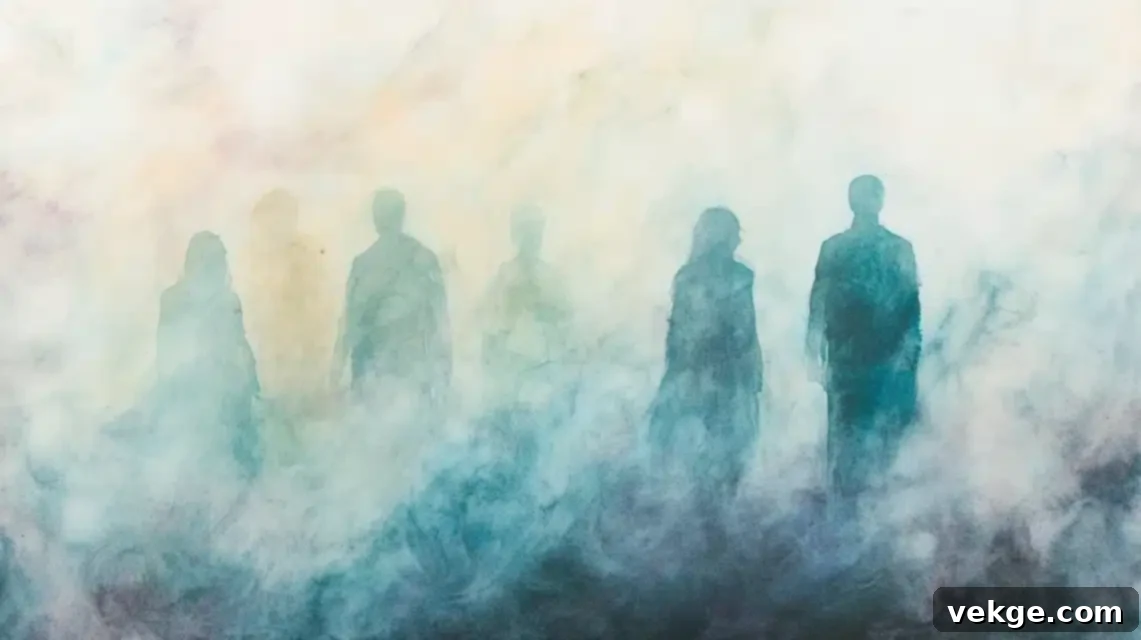
In this technique, soft, diffused edges gracefully define ghostly forms as watercolors fluidly blend into delicate, misty apparitions. Each individual brush stroke demands impeccable timing and a keen sense of water control—too much water will result in undesirable puddles, while too little will cause the paint to dry too quickly, diminishing that essential ethereal quality. The choice of paper texture significantly influences the final appearance; rough surfaces tend to create spirits with a more textured, almost tactile feel, whereas smooth hot-press paper facilitates flawless transparency and crispness. Observe how colors organically merge at the edges, naturally forming subtle auras around each spectral figure. Strategic control over water application is key to building profound depth through successive, layered washes.
Complete Painting Process:
- Prepare Paper: Begin by carefully stretching high-quality watercolor paper, ensuring perfect surface tension for consistent and controlled washes.
- Build Background: Establish an atmospheric background using graduated washes of pale, muted colors, setting the mood and creating initial depth for your ghostly figures.
- Layer Ghost Forms: Construct ghost forms by layering transparent whites and pale, subtle colors, employing careful lifting techniques to create soft, undefined edges.
- Define Shadows & Highlights: Create shadows and highlights through negative painting, working around the delicate edges of your spirit forms to enhance their presence.
- Add Ethereal Details: Apply final delicate details with slightly tinted white paint, using fluid strokes to suggest gentle, ethereal movement and a fleeting presence.
3. Haunted Forest Apparitions
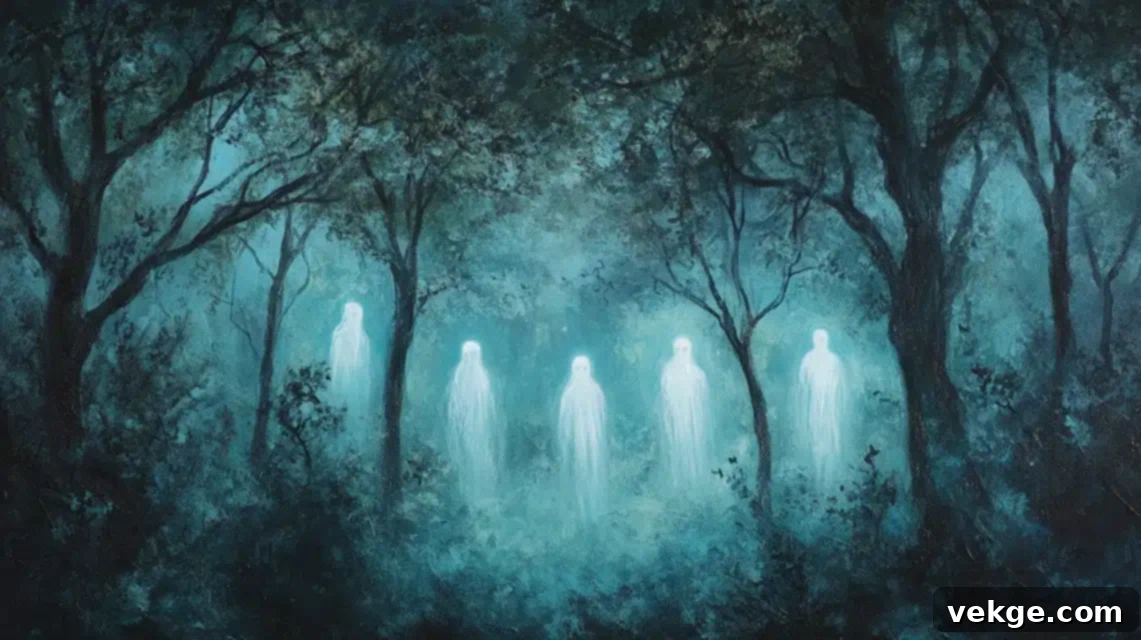
Deep, encroaching shadows that intertwine between ancient, twisted trees offer ideal, mysterious hiding spots for elusive ethereal visitors. Unlike typical, bright forest landscapes, this particular technique demands an exquisite and careful balance between profound darkness and the subtle, ghostly illumination of your apparitions. Observe how morning mist effects gradually develop through numerous layered glazes—each successive coat meticulously builds a deep, eerie atmosphere while carefully preserving the luminous forms of your spirits. Strategically placed branches artfully frame the supernatural elements, gently guiding the viewer’s eyes through the dramatic composition. Reflect on how moonlight interacts with and transforms various sections of your forest scene; silvery highlights delicately gracing the branches should contrast dramatically with the deep, inky shadows where spirits silently lurk, creating an unparalleled sense of dramatic depth and mystery.
Complete Painting Process:
- Establish Forest Foundation: Lay down a dark forest base using deep greens, blues, and grays, building multiple layers to achieve rich, atmospheric depth.
- Create Tree Structures: Form tree structures through careful negative painting, preserving lighter areas within the dark background where ghosts will later reside.
- Layer Translucent Spirits: Apply translucent white spirits using delicate dry brush techniques over a slightly wet background to achieve soft, diffused edges.
- Build Ethereal Movement: Suggest spectral motion and flow through precise, directional brushstrokes, making the apparitions appear to drift through the scene.
- Add Supernatural Glow: Apply final highlights using pure titanium white mixed with a pearlescent medium to create a truly otherworldly, supernatural glow.
4. Vintage Specter Style
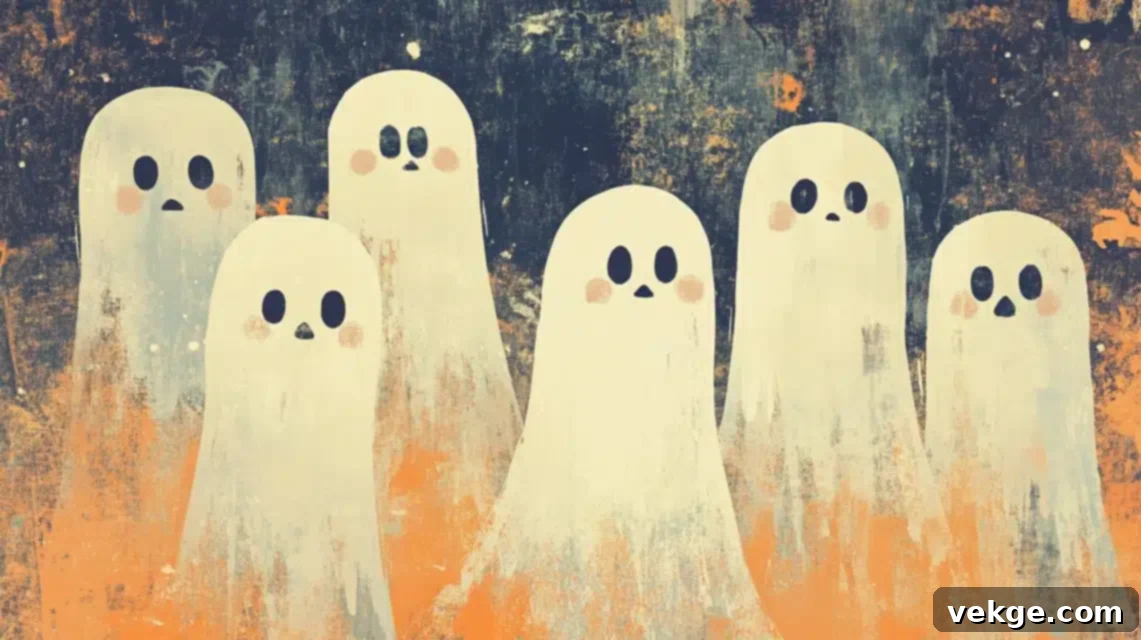
To successfully capture the quintessential charm of a 1950s Halloween card, a deep understanding and appreciation of historical color palettes are absolutely essential. Recent artistic endeavors have vividly demonstrated how even the most subtle color shifts can effortlessly transform contemporary ghost depictions into wonderfully nostalgic apparitions, rich with a bygone era’s charm. Each ghost, rendered in this vintage style, narrates its own unique story through carefully exaggerated expressions and classic, often playful poses. Notice how a deliberately limited color palette—featuring muted oranges, soft warm grays, and creamy whites—significantly enhances the overall vintage appeal. Strategic aging effects, such as delicate color fading, the simulation of authentic paper texture, and meticulously planned “wear and tear,” are crucial in building an authentic and compelling vintage character that transports viewers back in time.
Complete Painting Process:
- Create Aged Base: Start by creating an aged paper effect using coffee staining or a very light, warm watercolor wash, providing an authentic, period-appropriate base.
- Sketch Classic Shapes: Sketch classic ghost shapes, strongly emphasizing the rounded forms and wonderfully expressive features characteristic of vintage illustrations.
- Apply Flat Colors: Apply flat color areas using a carefully curated, period-appropriate palette mixed with slightly muted, desaturated tones for an authentic vintage feel.
- Add Worn Effects: Create convincing worn effects through strategic erasing, subtle texturing, and delicate dry-brushing to mimic age and gentle decay.
- Build Final Details: Refine final details using precise line work that strongly emphasizes the clean, bold lines typical of classic cartoon and illustration styles of the era.
5. Misty Cemetery Scene
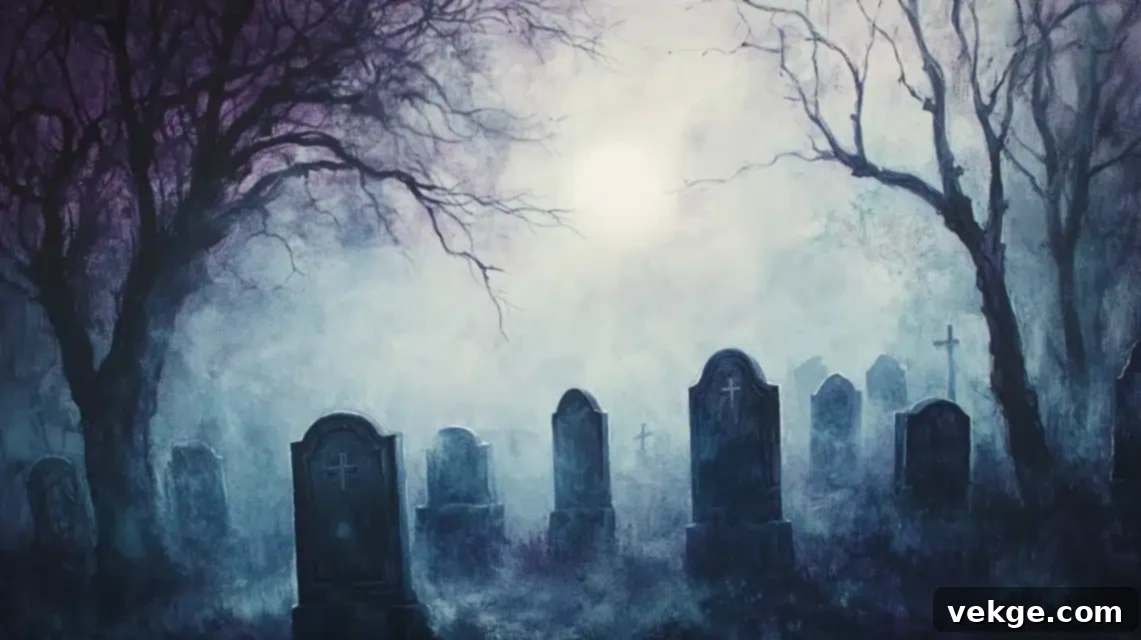
In contrast to traditional, brightly lit landscape paintings, cemetery scenes infused with ethereal spirits demand an unparalleled level of atmospheric control and nuance. The recreation of an authentic morning fog effect necessitates patient and delicate layering—each successive wash meticulously builds profound depth while simultaneously preserving the delicate, ghostly transparency of the apparitions. Observe how the distinct shapes of tombstones gracefully emerge through careful lifting techniques, while translucent spirits appear to float serenely through the meticulously crafted mist. Strategic control over value ensures that your ghosts stand out with striking clarity without ever compromising the overall atmospheric unity of the scene. Reflect on how different times of night can dramatically alter your scene; early evening often brings with it soft, melancholic blue shadows, while the deep hours of midnight can suggest richer, more profound purples and blacks, enhancing the mystery.
Complete Painting Process:
- Create Misty Foundation: Begin by establishing a misty foundation using multiple, very light washes of diluted color, gradually building up atmospheric depth and an ethereal quality.
- Develop Tombstone Forms: Define tombstone forms through precise negative painting and careful attention to edge control, allowing them to emerge from the mist.
- Layer Ghost Figures: Apply ghost figures using white paint blended with a glazing medium, creating subtle, transparent effects that allow the background to show through.
- Build Depth: Enhance depth by strategically darkening background elements, ensuring foreground luminosity remains intact to highlight the spirits.
- Add Ethereal Light: Apply final touches with a subtle iridescent medium, carefully creating delicate, ethereal light effects that shimmer with a spectral glow.
6. Victorian Mansion Mysteries

Behind each intricate window pane, delicate, wispy figures engage in their eternal waltz, forever bound to the grand Victorian mansion. Through ornate moldings, towering turrets, and shadowed alcoves, ghostly inhabitants subtly peek and playfully drift. The mansion itself transcends mere architecture, becoming a character imbued with centuries of stories, its weathered facade a silent testament to tales waiting to materialize. A recent painting session beautifully illustrated how the soft, flickering glow of candlelight emanating from within can transform simple window shapes into enchanting portals of possibility. Each shutter, rich with history, holds the potential for a spectral surprise, while gabled peaks dramatically pierce the moody, overcast skies above. As evening descends and shadows lengthen, that is precisely when our painted phantoms truly awaken and come alive, filling the scene with their silent, captivating presence.
Complete Painting Process:
- Build Architectural Foundation: Establish a robust architectural foundation with precise perspective, creating the imposing and grand presence of a Victorian mansion.
- Layer Interior Glows: Carefully layer warm, inviting interior glows emanating from windows, subtly suggesting ghostly activities within the mansion’s depths.
- Create Ethereal Residents: Form ethereal residents using varied transparency levels and gentle, subtle movements to give them a fleeting, spectral quality.
- Develop Weathered Textures: Introduce weathered textures and patinas to the mansion’s exterior, greatly enhancing its historical atmosphere and sense of age.
- Add Luminous Touches: Apply final luminous touches and delicate highlights that bring the spirits to life, making them shimmer with an otherworldly glow.
7. Spectral Family Portrait

Imagine them gathering, as they do each year, for their timeless family portrait: Mother Ghost’s translucent pearls floating perfectly askew, while mischievous Baby Ghost tumbles playfully through Father Ghost’s stately top hat. Time itself stands eerily still within this ethereal family scene, forever frozen in a moment of supernatural domesticity. It is often the small, meticulously crafted details that narrate the grandest stories—a shimmering, translucent teatime set, an otherworldly game of fetch played with a beloved phantom dog, or a book floating gently in mid-air. The unique personality of each spirit shines brightly through carefully conceived expressions and distinct poses, creating compelling characters that viewers find themselves irresistibly drawn to, fostering a sense of warmth amidst the spectral.
Complete Painting Process:
- Design Formal Composition: Design a formal composition, carefully following traditional portrait structures but incorporating whimsical, ghostly twists.
- Develop Character Expressions: Develop distinct individual character expressions through detailed preliminary sketches, capturing the essence of each phantom.
- Build Ethereal Forms: Construct ethereal forms using layered translucent whites and subtle, barely-there colors to suggest their otherworldly nature.
- Create Spectral Attire: Render period-appropriate clothing and accessories, thoughtfully adapting them with spectral qualities to match their ghostly wearers.
- Polish Whimsical Details: Polish the final details with precision, strongly emphasizing personality and infusing the portrait with a playful, whimsical charm.
8. Oceanic Apparitions
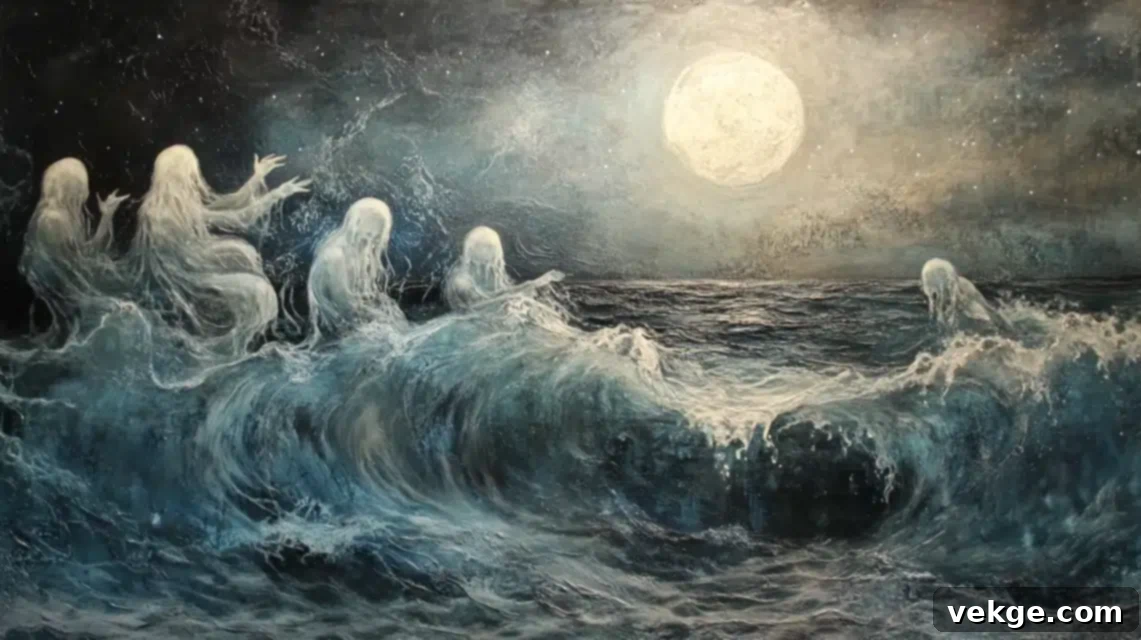
Under the luminous glow of the moon, silver light dances elegantly across the crests of waves, hinting at forgotten realms where merfolk once gracefully swam, now haunted by ancient, mystical sea spirits. Beneath starlit skies, spectral forms gracefully weave between the fluid realms of water and air, their very essence as boundless and fluid as the restless ocean waves themselves. Observe how the shimmering phosphorescent plankton mirrors a subtle, spiritual glow, creating a captivating double magic on your canvas. In these oceanic apparitions, the boundaries between the natural and the supernatural delightfully blur—is that truly sea spray catching the light, or is it the delicate, trailing form of a passing spirit? The beauty lies in the ambiguity, allowing viewers to ponder and decide for themselves, adding an interactive dimension to the artwork.
Complete Painting Process:
- Establish Seascape: Create a dramatic seascape background with a focus on moonlit water effects, establishing a sense of deep mystery and calm.
- Layer Ghost Forms: Apply ghost forms using techniques that mimic the natural flow and movement of water, making them seem integral to the ocean itself.
- Blend Atmospherics: Develop atmospheric effects that seamlessly blend natural elements like fog and spray with supernatural energy, creating a cohesive, mystical scene.
- Create Luminous Highlights: Form luminous highlights suggesting both the soft glow of moonlight and the inherent energy of the spiritual presences.
- Blend Edges: Skillfully blend the edges between the sky, sea, and spirit elements to achieve a harmonious and utterly seamless composition.
9. Luna’s Ghostly Gathering
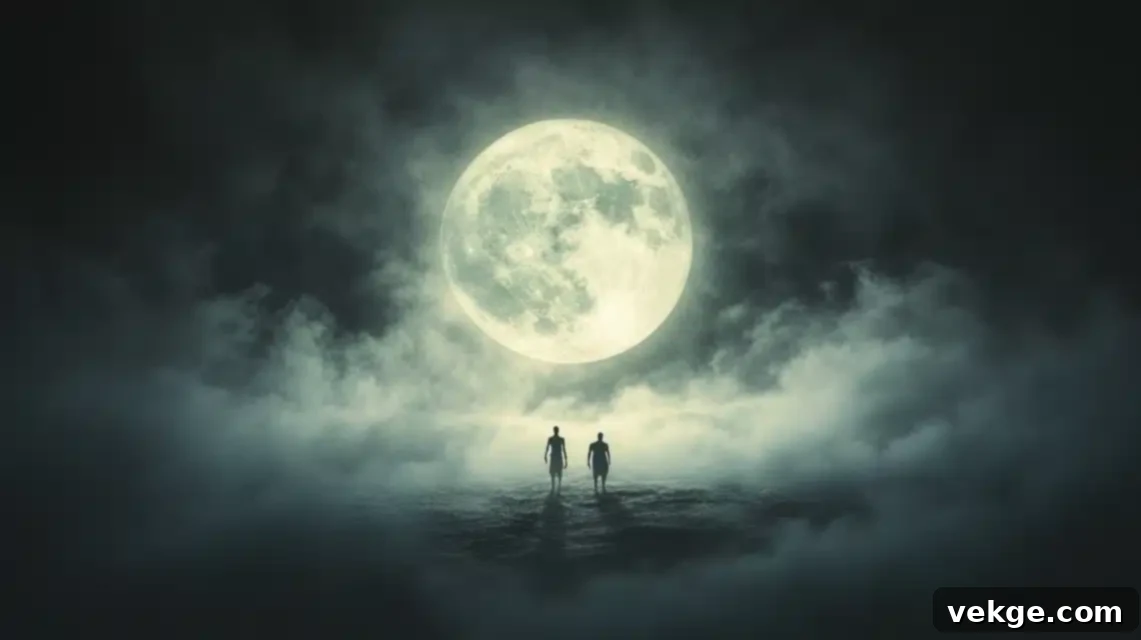
Under the ancient and watchful eye of Grandmother Moon, spirits gracefully swirl and dance in their timeless midnight minuet. Each deliberate brushstroke carries with it the gentle whispers of ancient, untold stories, as phantoms elegantly glide and weave through the captivating lunar light. Observe how the clouds dramatically part, strategically creating spotlight moments for our ethereal performers, casting a dramatic glow upon their forms. Light and shadow engage in a delicate, captivating game of hide-and-seek across the canvas, with spirits emerging from the profound depths of darkness only to softly fade once more into the embracing arms of the night. This interplay creates a dynamic tension and a sense of fleeting beauty, making each spirit’s appearance both precious and momentary.
Complete Painting Process:
- Create Dramatic Night Sky: Paint a dramatic night sky, emphasizing the moon’s powerful and luminous presence as the central light source.
- Build Ghost Forms: Construct ghost forms through the strategic removal or subtle layering of dark paint, allowing their light essence to shine through.
- Develop Cloud Structures: Create expressive cloud structures that frame and enhance the supernatural elements, directing the viewer’s eye towards the spirits.
- Layer Translucent Spirits: Layer translucent spirits with delicate washes and glazes, suggesting fluid movement and an effortless flow through the air.
- Polish Atmospheric Effects: Refine atmospheric effects, adding subtle mists and glows to enhance the mystical mood and deepen the sense of otherworldly magic.
10. Dia de los Muertos Spirit Dance
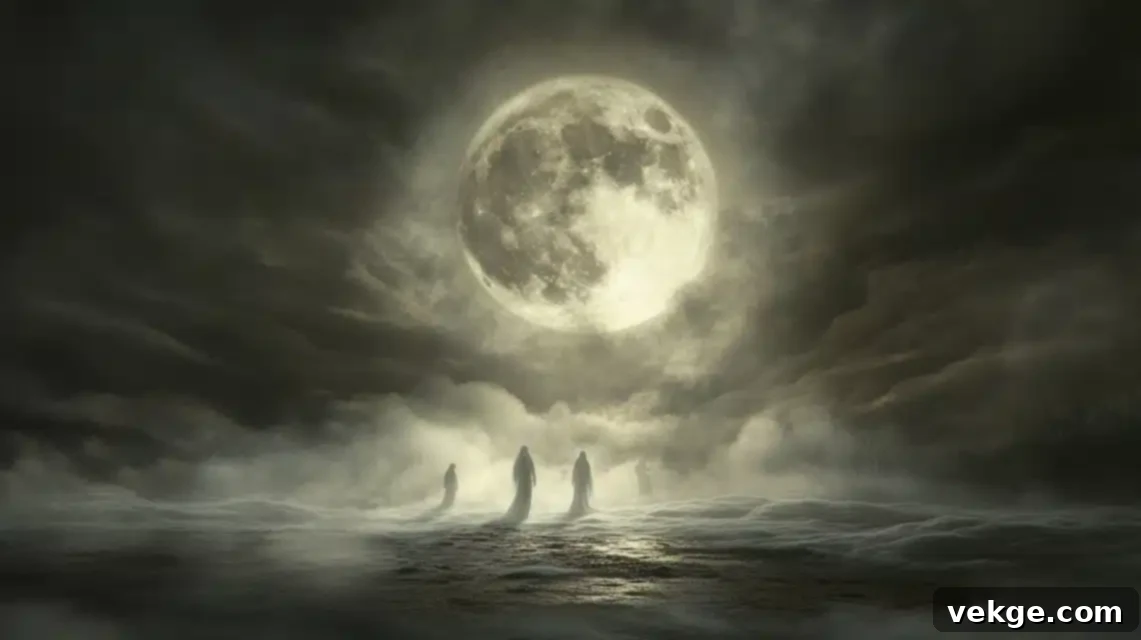
Departing from the often somber themes of traditional ghost paintings, these vibrant spirits engage in a joyous celebration, bursting with explosive color and dynamic movement. Recent studio explorations have illuminated how integrating rich cultural artistry can utterly transform simple specters into beautifully decorated souls, gracefully dancing between worlds. Observe how brilliant marigold oranges intricately weave through ethereal forms, while classic sugar skull patterns gracefully emerge from meticulously applied translucent layers. Each ghost, in this celebratory context, tells its own profound story through thoughtfully chosen symbols—perhaps a baker’s spirit adorned with painted bread motifs, or a musician’s ghost trailing delicate, painted music notes. Morning light captures the metallic details in a way distinctly different from evening shadows; consider how delicate gold leaf accents can brilliantly catch candlelight, transforming seemingly simple spirits into luminous celebrations of both life and the cycle of death, honoring ancestors with vivid reverence.
Complete Painting Process:
- Begin with Spirit Forms: Start by outlining spirit forms using a warm white base, suggesting transparency and inherent movement.
- Layer Intricate Patterns: Apply intricate pattern work, drawing inspiration directly from traditional sugar skull designs and Mexican folk art.
- Create Dimensional Effects: Introduce dimensional effects through careful application of metallic paints and genuine gold or silver leaf, adding sparkle and richness.
- Develop Fabric Flow: Render fabric-like flow in their clothing, subtly incorporating traditional textile patterns to enrich their cultural identity.
- Build Final Highlights: Apply final highlights that emphasize a celebratory mood rather than sorrow, showcasing the joy and remembrance of Dia de los Muertos.
11. Liquid Spirit Study
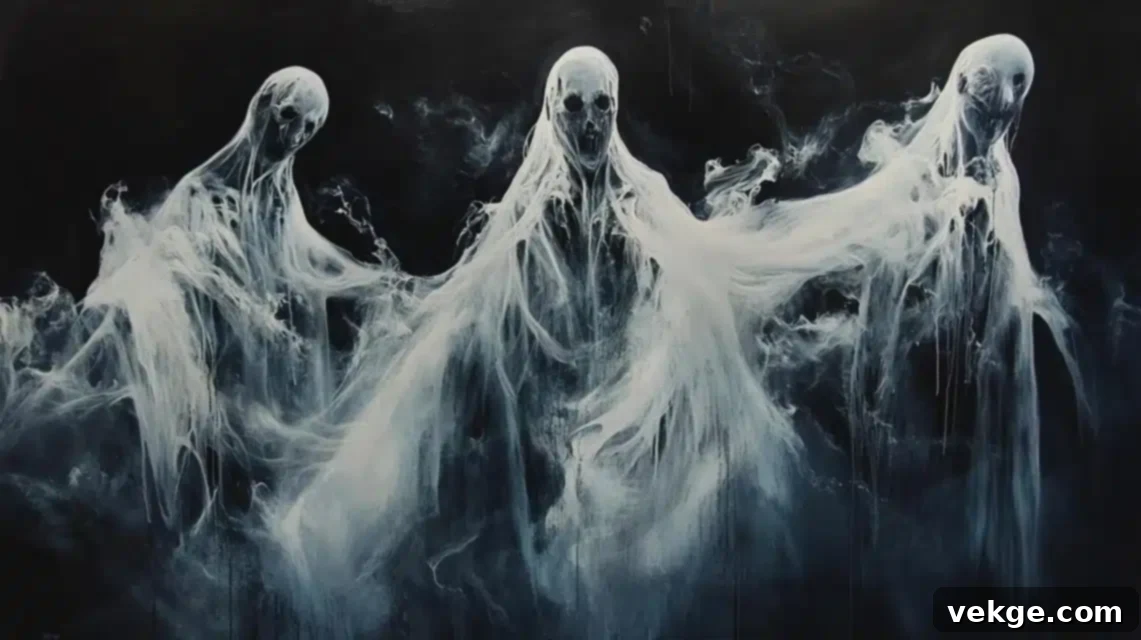
These spirits deliberately defy conventional ghost forms, appearing to be suspended captivatingly between different states of matter. Their essence flows with the fluidity of water, yet it retains shape and presence like delicate smoke, powerfully challenging the viewer’s preconceived expectations. Each figure typically begins with a somewhat solid core, then gradually and elegantly dissolves into atmospheric nothingness, creating a profound sense of transition. Strategic drips of paint are transformed into intentional design elements—some exquisitely suggesting graceful, ongoing movement, while others subtly imply eternal, lingering tears. Recent experiments have conclusively demonstrated how varying paint consistencies are crucial in creating diverse effects; thick impasto adeptly holds to form, providing solidity, while delicate, liquid glazes beautifully convey a truly supernatural flow and ethereal quality.
Complete Painting Process:
- Start with Fluid Shapes: Begin by establishing basic ghost forms using fluid, abstract shapes, allowing for organic and flowing outlines.
- Build Dimensional Effects: Create striking dimensional effects through meticulously controlled paint viscosity, layering thick and thin applications.
- Layer Translucent Colors: Apply translucent colors in layers, building depth and luminosity within each spirit, making them glow from within.
- Develop Drip Patterns: Deliberately develop compelling drip patterns, allowing gravity to become a collaborative and creative partner in your design.
- Create Final Definition: Achieve final definition and sharpness through strategic edge control, ensuring key elements of the spirits are clearly discernible.
12. Friendly Phantom Fellowship

Breaking away from conventional spooky traditions, these delightful spirits radiate joy and cheer rather than instilling fear. The gentle morning light in the studio beautifully revealed how subtle and carefully chosen color variations can magically transform potentially intimidating apparitions into wonderfully welcoming, friendly companions. The unique personality of each ghost gracefully emerges through meticulously crafted expressions—a slight, endearing curve of a smile here, a gentle, inquisitive tilt of the head there. Soft pastel backgrounds provide a harmonious and supportive backdrop, ensuring they enhance rather than compete with the spirits, allowing our spiritual friends to float together in serene and peaceful harmony. Observe how different brush techniques profoundly affect their character: soft, rounded brushes create friendly, inviting curves, while crisp angle brushes impart a sense of playful movement and lightheartedness.
Complete Painting Process:
- Create Welcoming Atmosphere: Establish a warm and welcoming atmosphere using soft, inviting pastel background washes, setting a cheerful tone.
- Develop Distinct Personalities: Develop distinct personalities for each ghost through detailed expression studies, giving them unique emotional qualities.
- Build Ghost Forms: Construct ghost forms using varying opacity levels, from nearly opaque to barely-there transparent, to create depth and individuality.
- Layer Subtle Colors: Apply subtle, nuanced colors that gently suggest individual character traits, such as a blush of pink or a hint of blue.
- Polish Friendly Interaction: Polish the final details, carefully emphasizing friendly interaction and a sense of delightful camaraderie among the phantoms.
13. Haunted House Transparency Tales

The morning light streams beautifully through my latest piece, elegantly revealing how meticulously applied layers can build intricate stories within stories. Unlike solid, imposing figures, these spirits playfully toy with perception—appearing tangibly solid one moment, only to become delicately transparent the next. Observe how the architectural details of the haunted house subtly peek through the ethereal forms, creating a compelling visual dialogue between enduring structure and fleeting spirit. Each ghost, in this context, becomes an intrinsic part of the house’s long history, their transparency gracefully revealing tantalizing glimpses of faded wallpaper, intricate window frames, and ancient wooden beams beneath. Strategic brushwork is key in determining precisely how much of the house is revealed through each spirit; some areas may remain almost opaque, powerfully suggesting stronger, more manifest presences, while others barely disturb the view of the room beyond. Consider how different times of day dramatically affect ghost visibility; morning light might unveil only the most subtle of spirits, while the deep, lengthening evening shadows actively encourage their full, haunting presence.
Complete Painting Process:
- Begin Architectural Rendering: Start with a detailed architectural rendering, establishing a solid and believable house structure as the foundation.
- Create Ghost Mapping: Map out ghost placements and interaction points, determining how they will interact with and flow through house features.
- Layer Translucent Spirit Forms: Apply translucent spirit forms using carefully controlled opacity levels to create a sense of being both present and ethereal.
- Develop Intersection Points: Focus on developing intersection points where spirits appear to pass through solid objects, enhancing the illusion of transparency.
- Build Atmospheric Effects: Create atmospheric effects like subtle fog or dust motes, significantly enhancing the supernatural presence and mystery.
- Add Final Highlights: Incorporate final luminous highlights that suggest movement between dimensions, making the spirits seem active and alive.
- Create Shadow Effects: Develop shadow effects to reinforce the ghosts’ placement within the space, grounding their otherworldly presence in the environment.
14. Retro Speech Bubble Spirits
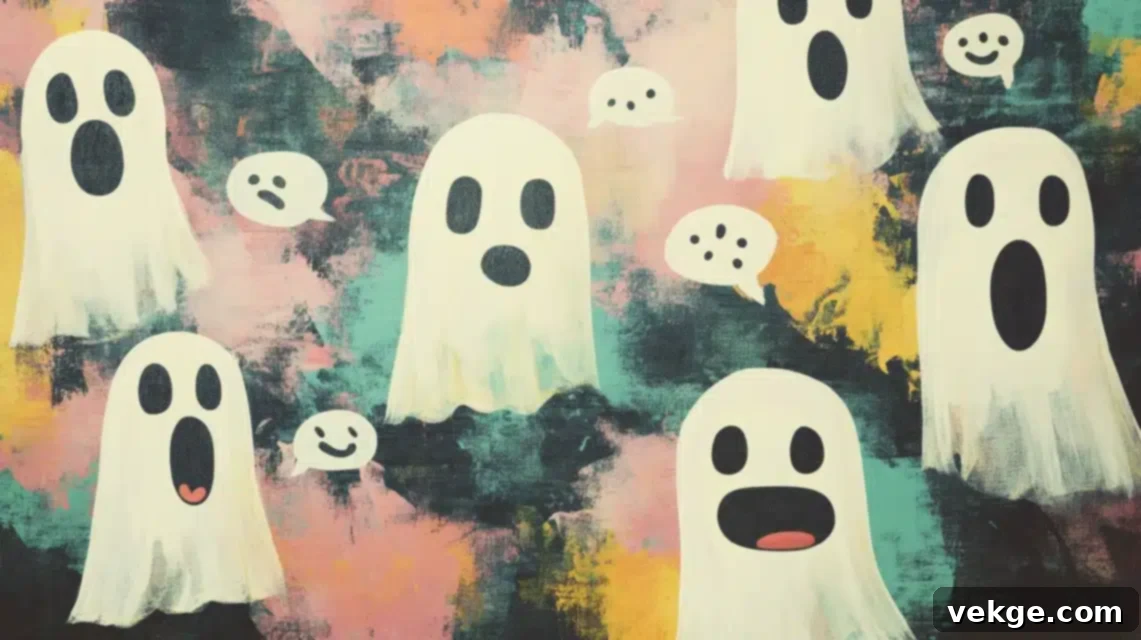
Recall those delightful comic book ghosts who conversed in perfectly rounded speech bubbles? This technique aims to lovingly resurrect them with a fresh, modern flair. Each phantom gracefully floats mid-conversation, their charming dialogue bubbles becoming an integral and dynamic part of the artistic composition. Observe how vintage-inspired colors—soft mint greens, muted dusty pinks, and faded yellows—effortlessly transform contemporary spirits into precious, nostalgic treasures, evoking a sense of sweet yesteryear. Strategic placement of these bubbles creates engaging visual conversations that playfully span across the canvas, inviting viewers to imagine the spectral chatter. Some spirits whisper secrets, their bubbles small and intimate, while others boldly proclaim their presence with enthusiastic exclamation points that dramatically pierce their gentle, ethereal halos, adding a touch of whimsical drama to the scene.
Complete Painting Process:
- Establish Retro Color Palette: Curate and establish a retro color palette, drawing deep inspiration from vintage comic books and classic illustrations.
- Design Spirit Characters: Design distinct spirit characters with styling that is authentically period-appropriate, reflecting the chosen vintage era.
- Create Dynamic Speech Bubble Placement: Strategically place dynamic speech bubbles to enhance the overall composition and guide the narrative flow.
- Layer Weathering Effects: Apply subtle weathering effects, such as gentle fading or distressed textures, to suggest age and add character to the artwork.
- Build Final Highlights: Introduce final highlights that brightly emphasize the vintage charm, making the spirits and their dialogue pop with playful energy.
15. Pop Art Phantoms
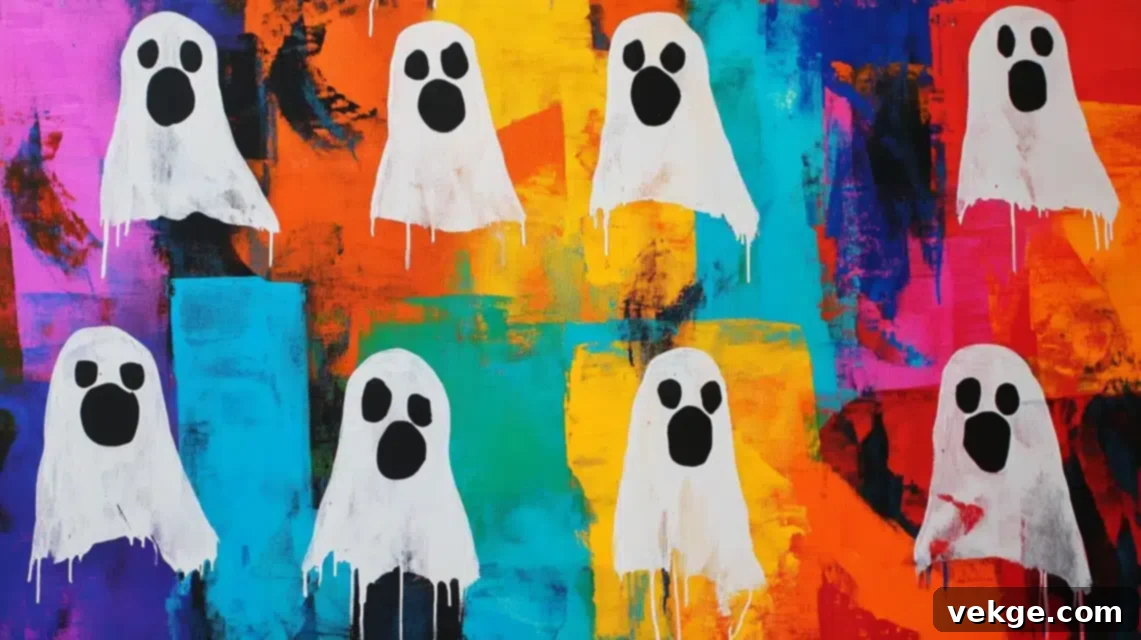
Imagine Andy Warhol encountering ectoplasm—this technique presents a bold and vibrant interpretation of spiritual art. Unlike more traditional ghost paintings, these phantoms demand immediate attention through their striking, vibrant colors and sharp, powerful contrasts. Each ghost is transformed into a compelling statement piece, often repeated across the canvas with varying, eye-catching color combinations, thereby creating a mesmerizing rhythmic pattern and visual energy. Studio sessions have vividly demonstrated how the strategic addition of fluorescent touches can instantly transform simple spirits into electrifying, almost animated apparitions. Consider deeply how different background colors can dramatically influence each ghost’s presence; some colors possess the power to push spirits boldly forward, making them intensely present, while others effectively create an eerie, haunting depth, pulling them back into the mysterious shadows.
Complete Painting Process:
- Design Ghost Motif: Develop a distinctive ghost motif that is ideal for repetition and bold color variation, aligning with pop art aesthetics.
- Create Bold Background Blocks: Paint bold, flat background blocks of color, establishing a strong and graphic pop art foundation for your composition.
- Layer Spirit Forms: Apply spirit forms using striking, contrasting color combinations that make them visually pop against the background.
- Develop Clean Edges: Ensure meticulously clean, sharp edges on all elements, which is absolutely essential for achieving the iconic pop art style.
- Build Final Details: Add final details that intensely emphasize the graphic impact and overall visual punch, making the artwork vibrant and engaging.
Final Thoughts on Your Ethereal Creations
Stepping back from a newly completed ghost painting always instills a profound sense of wonder, serving as a powerful reminder of how incredibly thin the veil truly is between pure imagination and tangible art. Through these fifteen diverse techniques, we have collectively explored the fascinating journey of how simple pigments and mindful strokes can beautifully transform into captivating spiritual storytelling.
It’s crucial to remember that ghost painting transcends mere technical proficiency; it’s ultimately about skillfully capturing those fleeting, almost imperceptible moments that exist between heartbeats, those whispers of the unseen that linger in the air. Sometimes, your most successful and evocative spirits will serendipitously emerge from what initially appear to be “mistakes”—when paint flows unexpectedly, or colors blend in surprisingly magical ways, creating unforeseen depth and ethereal beauty. Embrace these happy accidents as integral parts of your creative process.
Technical Tips to Remember for Ghostly Art:
- Vary Your Whites: Keep your whites exceptionally pure, but allow for significant variation in their application. Every ghost possesses its own unique narrative, best told through distinct opacity levels and subtle tonal differences.
- Embrace “Happy Accidents”: Actively embrace unexpected flows and blends. Sometimes, paint running in an unanticipated way can serendipitously create the most perfect, fluid spiritual movement.
- Engage Backgrounds: Allow your backgrounds to actively participate in and contribute to your ghost stories, rather than merely serving as static support. Let them interact and inform the spectral presence.
- Document Your Process: Make a habit of documenting your artistic process. Each new technique you discover and master significantly builds upon and enriches your personal supernatural artistic vocabulary.
Frequently Asked Questions About Ghost Painting
What Kind of Paint Should I Use for Ghost Painting?
For achieving truly ethereal effects, I highly recommend beginning with acrylic whites, thoughtfully mixed with a glazing medium. This specific combination allows for nuanced layering, creating beautiful transparency while maintaining excellent control over your brushstrokes. Watercolors are exceptionally adept at rendering misty, atmospheric effects with delicate blends. Conversely, oil paints provide rich, profound depth for darker, more dramatic scenes, offering a luxurious finish. For those captivating glow-in-the-dark effects, a high-quality phosphorescent paint, carefully mixed with white, will create the perfect, enchanting spiritual luminescence.
How Do I Participate in The Ghost Painting Trend on TikTok?
To join the popular ghost painting trend on TikTok, start by acquiring thrifted landscape paintings. These provide an ideal, ready-made background that is perfect for adding your spectral inhabitants. Use titanium white paint, blended with a glazing medium, to achieve beautifully transparent and wispy effects. Make sure to film your entire process, focusing particularly on the gradual formation of the ghosts through careful layering. Remember, when creating viral-worthy spirit art for social media, often less is indeed more; subtlety and intriguing ambiguity tend to capture attention most effectively.
What Are Some Easy Ghost Painting Ideas for Beginners?
For beginners looking to dive into ghost painting, start with simple ghost silhouettes against vibrantly colorful backgrounds. Practice rendering basic ghost shapes using white paint on dark paper to get a feel for the forms. Try creating moonlit scenes where the spirits only need to suggest their presence subtly, rather than requiring intricate detail; this reduces pressure and allows for experimentation. Beginning with smaller canvases is also beneficial, as it allows for quicker completion of projects while you are still learning and mastering various techniques, building confidence with each piece.
How Can I Paint Ghosts on Thrifted Artwork?
When painting ghosts on thrifted artwork, first, perform a small paint adhesion test on an inconspicuous corner of the piece to ensure compatibility. Then, create your spirits using thin, translucent layers of white paint, allowing elements of the original artwork to subtly show through, which adds character and history to your new creation. Carefully consider the placement of your ghosts to ensure they complement, rather than detract from, the existing composition. Always use quality paint to prevent any cracking or peeling over time, preserving both the original and your additions. It’s also a good practice to document the original artwork with a photograph before adding your supernatural residents, creating a record of its transformation.
What Techniques Can I Use to Make My Ghost Painting Unique?
To make your ghost painting truly unique, embark on an exploration of unusual color combinations that extend beyond the conventional whites and grays. Experiment with a variety of different tools—beyond just brushes—to create diverse and intriguing spirit textures, such as sponges or palette knives. Integrate mixed media elements into your work, like glow powder for an otherworldly shimmer, or metallic leaf for an unexpected touch of luxury. Give significant thought to environmental interactions, exploring how your spirits interact with their surroundings. Ultimately, by consistently modifying and refining your chosen techniques, you can develop a distinct signature style that makes your ethereal art instantly recognizable and uniquely yours.
